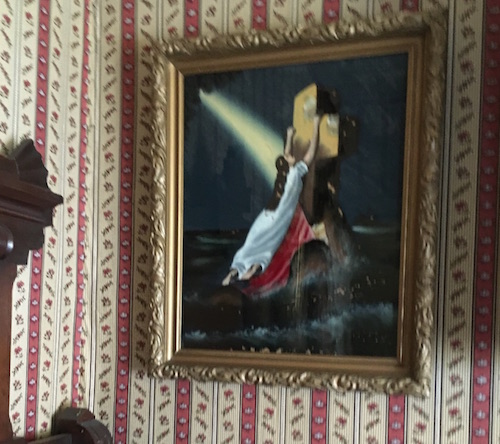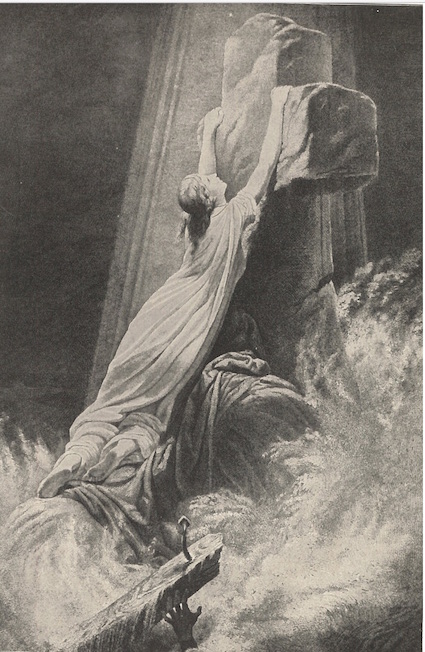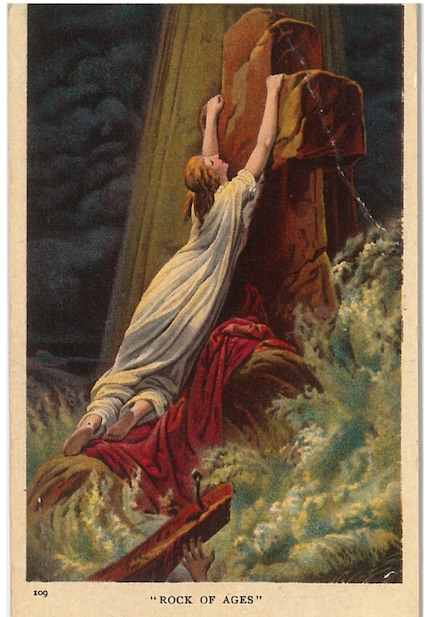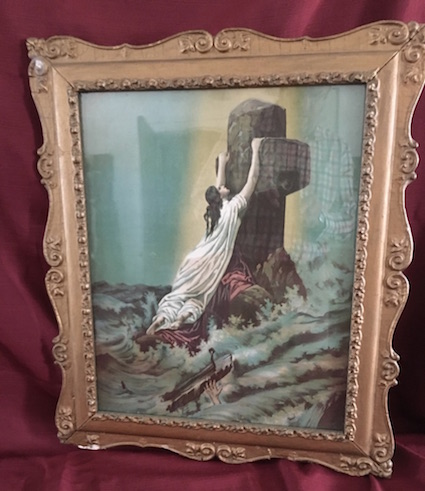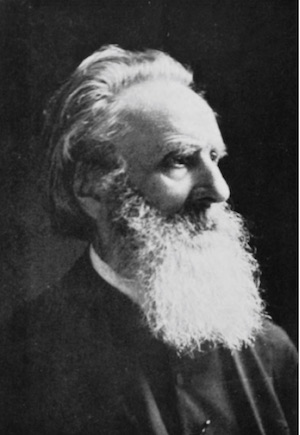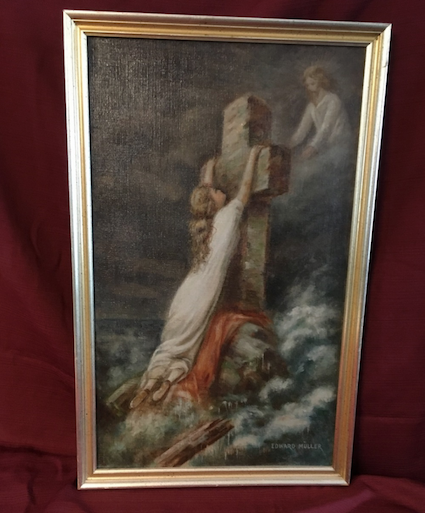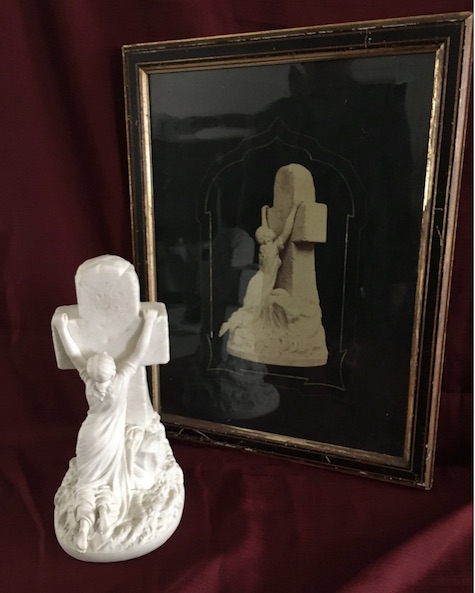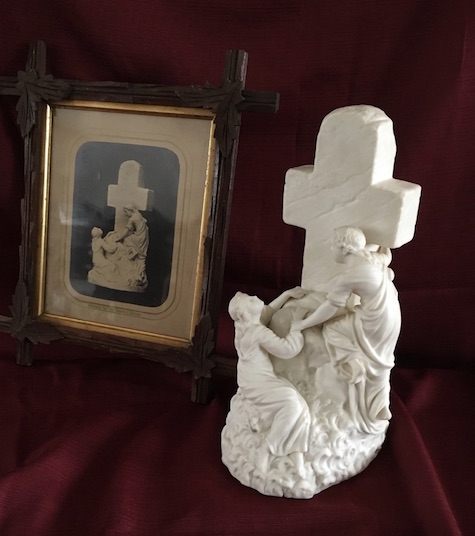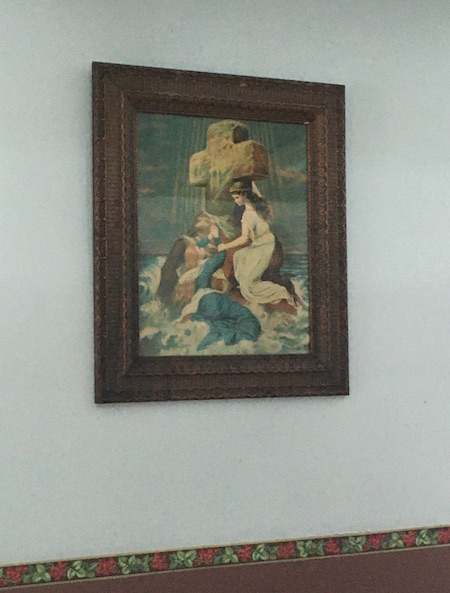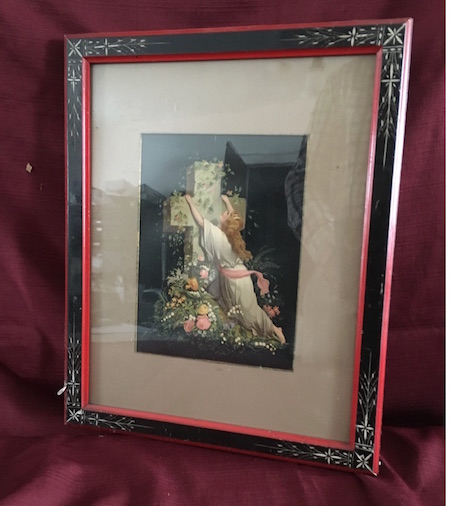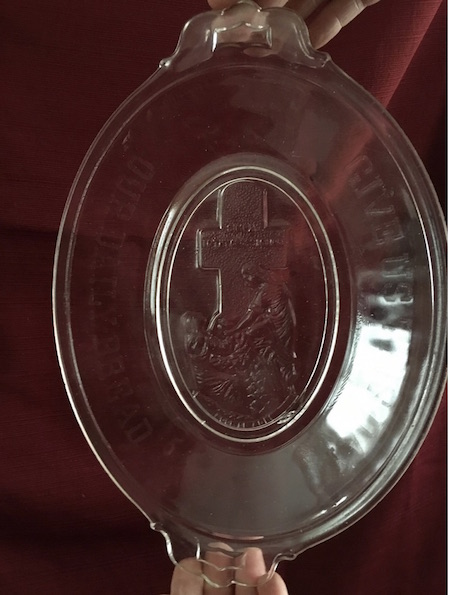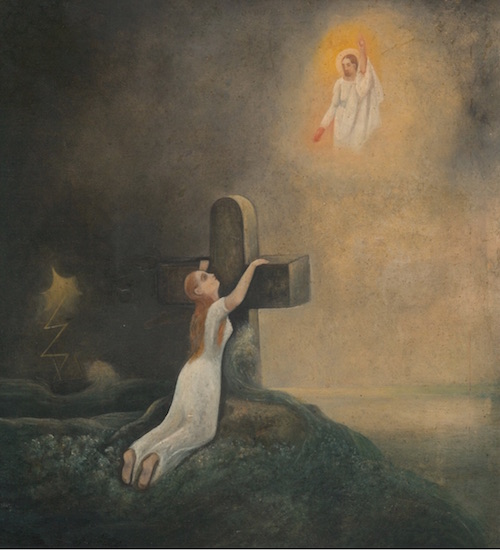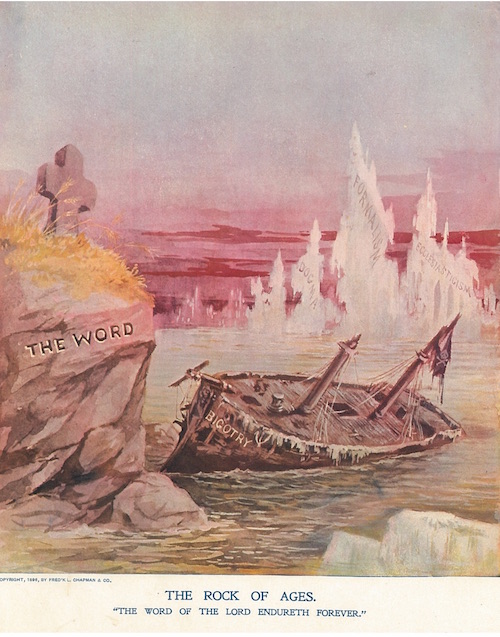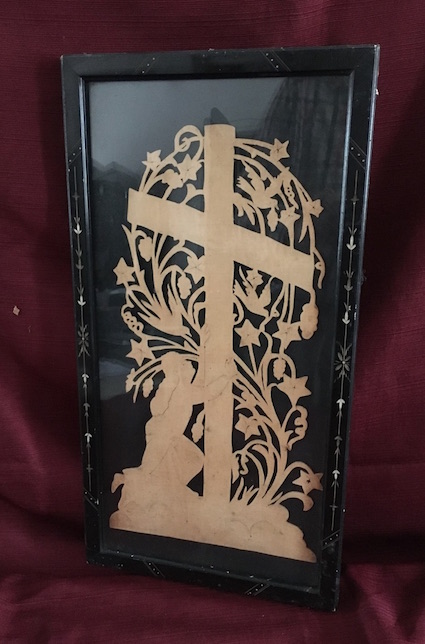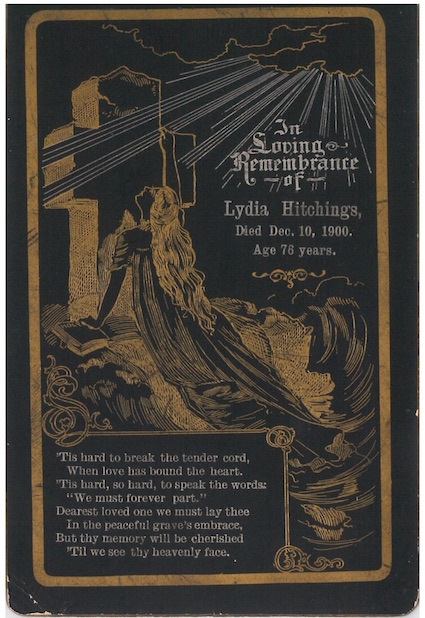Historic Childs: Popular Images of Yesteryear, Part 5 – Rock of Ages
By Bill Lattin and Doug Farley – Vol. 3 No. 6
GAINES – Undoubtedly, one of the most popular images from the Victorian era, and one of the most widely reproduced, was “Rock of Ages.” We show first a reverse painted copy on glass which hangs in the Cobblestone Museum’s Ward House.
This painting measuring 16”x20” was no doubt created by an amateur painter in the 1890s. We note that the artist included some pieces of mother-of-pearl shell on portions of the cross. These are affixed to the back side of the glass.
From the “Crown Jewels of Art,” published in 1899, we find the above illustration of this original allegorical painting. Franklin Edson Belden, author of the above mentioned book, described J. A. Oertel’s painting of Faith (Rock of Ages) in most melodramatic Victorian language. It follows here after a postcard when U.S. postage for such was one cent.
“Dark roll the waves at thy feet, O beautiful Faith, but the everlasting Rock, bathes in the sunlight of heavenly love, standeth unmoved. The beakers may surge and dash; but thy strength is sure. Dread sinking forms may lift their hideous hands to drag thee down, but purity will keep thee safe. Wrecks of time may toss unanchored, hurrying on to unknown seas, but thou art still looking upward into glory. And above the splashing spray, above the breakers’ roar, thy voice floats ever, – “Rock of Ages, cleft for me, let me hide myself in thee; let the water and the blood, from thy wounded side that flowed, be of sin and perfect cure; save me, Lord, and make me pure.”
“Thus Faith lives above the seething flood, and reaching up with steadfast arms clasps the emblem of Redemption, while triumphant o’er the wrecks of time; all the light of sacred story gathers round its head sublime. When the woes of life o’ertake me, hopes deceive and fears annoy, never shall the cross forsake me; lo, it glows with peace and joy. When the sun of bliss is beaming light and love upon my way, from the cross the radiance streaming, adds new luster to the day. Bane and blessing, pain and pleasure, by the cross are sanctified; peace is there that knows no measure, joys that through all time abide.”
This lithograph measuring 16”x 20” and all the following examples belong to Bill Lattin except where noted.
J.A. Oertel based his painting and several other variations on the hymn, “Rock of Ages, Cleft for Me.” This popular hymn in Protestant churches was written by Augustus Toplady in 1776.
Now to the artist, Johannes Adam Simon Oertel (1823-1909). He was born in Bavaria and studied art and painting in Nuremburg and Munich. Following his studies he earned a living by engraving, until he came to the United States in 1848. Here he continued to do engraving, paint portraits and hand color photographs. He also worked on interior decorations in the U.S. Capitol in Washington, D.C.
During the Civil War, Oertel accompanied Gen. Burnside for several months in 1862 as an artist/illustrator. In the mid-1800s, after several years of study, he became an Episcopal clergyman. Concurrently he was also an instructor of art at Washington University in St. Louis. During the last two decades of his life, he lived near Washington D.C. spending his time making religious paintings and wooden carvings which he gave to churches. His famous “Rock of Ages,” was created in 1868.
This painting, an oil on canvas measuring 14”x23”, was done by a Sunday Painter circa 1890. In it we see Faith not only clinging to the rugged cross, but also reaching to Jesus above. “When I soar to worlds unknown, I will see thee on thy throne.” The artist for this, Edward Mueller, signed his own name to this which is a no-no! What he should have done is letter the words, “After Ortel, by Edward Muller” or not signed this copy at all.
“Rock of Ages” was not only reproduced in two dimensional form, but also in statuary. This very fine piece of Parian marble, measuring 13” in height, would have been cast circa 1875-1880. The print shown here of the same timeframe, is an exact photocopy of the Parian statue above. We suppose that the fine Parian ware was expensive. So, if you couldn’t afford a classy statue, an economical framed print of the same would suffice.
Here is a second variation of the “Rock of Ages” entitled, “Simply to Thy Cross I Cling.” In this Parian ware example measuring 13” in height, Oertel illustrated Charity assisting Faith from the “splashing spray above the breakers roar.” An 1870s framed photo of the statue is also shown here.
This is one of several religious prints which has hung in the Cobblestone Church at Childs for a number of years. It, too, represents one of Oertel’s variations on the theme showing Faith and Charity.
In this example, Faith is shown amongst various flowers which take on a more funereal theme, as this image was often used.
This 1880s American pressed glass bread plate shows Faith and Charity. Lettered above them is “Simply to Thy Cross I Cling.” Below it states, “Rock of Ages.” Around the outer edges of this plate it states, “Give Us This Day, Our Daily Bread.”
Rock of Ages was so popular that even the very unskilled attempted to copy it as we see in this primitive example.
In this cartoon by Frank Beard, copyright 1896, we see his interpretation of our subject. The rock being “The Word,” the sinking ship “Bigotry,” and the melting icebergs, “Dogma, Formalism and Ecclesiasticism.” Beard based his cartoon on: “The grass withers, the flowers fade; but the word of our God shall stand forever.” Isaiah 40:8. All of the images go to show just how popular the Rock of Ages was in various forms during the Victorian Era.
Here is an example of Rock of Ages where a thin piece of wood was fashioned by use of a coping saw. The ivy leaves symbolize: memory, the doves: peace, which suggest this may have been a memorial to someone within its black presentation and frame.
We end with a funeral card from 1900 showing Faith holding steadfast to the “Rock of Ages.”
























